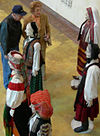
Yokohama is the second-largest city in Japan by population and the most populous municipality of Japan. It is the capital city and the most populous city in Kanagawa Prefecture, with a 2020 population of 3.8 million. It lies on Tokyo Bay, south of Tokyo, in the Kantō region of the main island of Honshu. Yokohama is also the major economic, cultural, and commercial hub of the Greater Tokyo Area along the Keihin Industrial Zone.

The Japanese Instrument of Surrender was the written agreement that formalized the surrender of the Empire of Japan, marking the end of hostilities in World War II. It was signed by representatives from the Empire of Japan and from the Allied nations: the United States of America, the Republic of China, the United Kingdom of Great Britain and Northern Ireland, the Union of Soviet Socialist Republics, the Commonwealth of Australia, the Dominion of Canada, the Provisional Government of the French Republic, the Kingdom of the Netherlands, and the Dominion of New Zealand. The signing took place on the deck of USS Missouri in Tokyo Bay on 2 September 1945.

Nissan Stadium, also known as International Stadium Yokohama, is a multi-purpose stadium in Yokohama, Kanagawa Prefecture, Japan, which opened in March 1998. It is the home stadium of Yokohama F. Marinos of the J1 League.

John Lennon Museum was a museum located inside the Saitama Super Arena in Chūō-ku, Saitama, Saitama Prefecture, Japan.
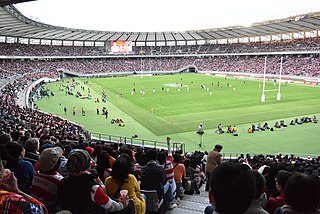
Ajinomoto Stadium, also known as Tokyo Stadium in AFC Champions League, is a multi-purpose stadium in Chōfu, Tokyo, Japan. The stadium was founded at Kantō Mura, the redevelopment area formerly used by United States Forces Japan, in March 2001. It was the first stadium in Japan that offered its naming rights, which were sold to Ajinomoto Co., Inc. with a 5-year 1.2 billion yen contract, from March 2003 to February 2008. As a result, it was named Ajinomoto Stadium. This contract was renewed in November 2007 and extended by 6 years for 1.4 billion yen to February 2014, and in October 2013, the second renewal of the contract extended the term to February 2019.

The Yokohama Curry Museum was a restaurant and historic museum of curry in the Isezakichō district of the port city of Yokohama, Japan, between 2001 and 2007. Different types of curry were available from a selection or restaurants, ranging from a full meal to a quick taste option.

Yokohama Chinatown is located in Yokohama, Japan, which is located just south of Tokyo. It is about 160 years old, with a population of about 3,000 to 4,000. Today, only a few Chinese people still live there, most being from Guangzhou.

Minatomirai Station is an underground railway station on the Minatomirai Line in Nishi-ku, Yokohama, Kanagawa Prefecture, Japan, operated by the third-sector railway operating company Yokohama Minatomirai Railway.

The Yokohama Archives of History in Naka ward, central Yokohama, near Yamashita Park, is a repository for archive materials on Japan and its connection with foreign powers since the arrival of Commodore Matthew Perry in 1853. The archives are next to Kaiko Hiroba where Commodore Perry landed to sign the Convention of Kanagawa.
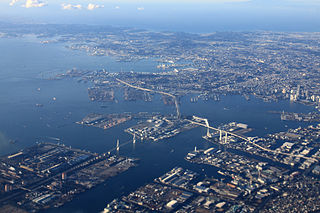
The Port of Yokohama is operated by the Port and Harbor Bureau of the City of Yokohama in Japan. It opens onto Tokyo Bay. The port is located at a latitude of 35.27–00°N and a longitude of 139.38–46°E. To the south lies the Port of Yokosuka; to the north, the ports of Kawasaki and Tokyo.
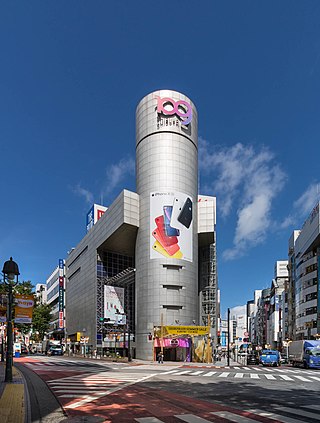
109 is a department store in Shibuya, Tokyo, Japan. The store is operated by SHIBUYA109 Entertainment Corporation, a subsidiary of the Tokyu Group.
Keio Media Centers is the English name used by Keio University to describe its library system.
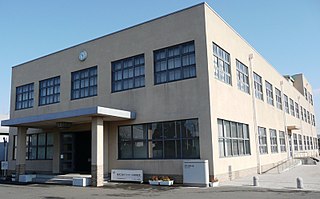
The Nissan Engine Museum is an automobile engine museum run by Nissan Motor Company. The museum is located at the first floor of the guest hall in Yokohama auto plant, Kanagawa-ku, Yokohama, Japan.

Yokohama Museum of Art, founded in 1989, is located in the futuristic Minato Mirai 21 district of the Japanese city Yokohama, next to the Yokohama Landmark Tower.

The Port of Tokyo is one of the largest Japanese seaports and one of the largest seaports in the Pacific Ocean basin having an annual traffic capacity of around 100 million tonnes of cargo and 4,500,000 twenty-foot equivalent units.

Cosmo Clock 21 is a 112.5 metre tall ferris wheel at the Cosmo World amusement park in the Minato Mirai 21 district of Yokohama, Japan. When it first opened, it was the world's tallest Ferris wheel, until the completion of the 108-metre (354 ft) Igosu 108 in Shiga, Japan, in 1992.
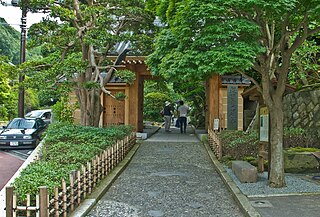
Hōkoku-ji (報国寺) is an old temple in the Kenchō-ji school of the Rinzai sect of Zen Buddhism located in Kamakura, Japan. Famous for its bamboo garden, it is also known as "Bamboo Temple".

The Hara Model Railway Museum is a model railway museum in Nishi-ku, Yokohama, Japan, which opened on 10 July 2012. Managed by Mitsui Fudosan, the museum houses the extensive collection of model trains built and amassed by the Japanese model railway enthusiast Nobutaro Hara. The museum covers an area of approximately 1,700 m², with the display area covering an area of approximately 1,200 m².

Meiji Maru (明治丸) is a Japanese sailing ship that serves as a museum ship in Tokyo. It is displayed at the Etchujima Campus of the Tokyo University of Marine Science and Technology.

The Nissan Heritage Collection is a private car gallery located in the Nissan engine manufacturing plant in Zama, Kanagawa, Japan.




















